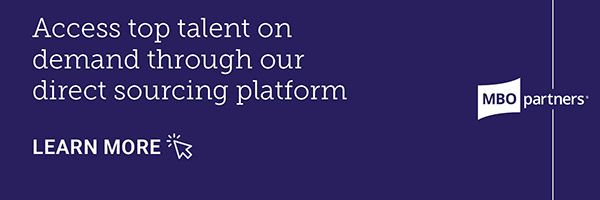How Does Direct Sourcing Work?

- Direct sourcing puts you in the driver’s seat when it comes to identifying and engaging top independent professionals.
- Direct sourcing benefits include reductions in recruiting time and cost, increased operating efficiencies, and faster “time to results.”
- There are several avenues for finding independent talent through direct sourcing.
- It’s best to take a long view of your direct sourcing strategy, starting with small test projects and building from there.
How Does Direct Sourcing Work?
Today’s workforce environment offers more options than ever before. Remote work is now the norm, and companies are not geographically limited in their talent searches. Hybrid work arrangements can help retain valued workers by offering more flexibility in the work week. Significant growth in the independent professional workforce, up 38% between 2020 and 2021, gives companies a key talent strategy that didn’t exist a few years ago—direct sourcing.
Direct sourcing puts enterprises in the driver’s seat when it comes to identifying and engaging top independent professionals. It also helps ensure that the right talent is hired for the right budget and offers the opportunity to curate a network of pre-vetted independent professionals and put you in prime position (in tandem with other initiatives like) to ensure they are available when needed.
The business benefits of direct sourcing
Five key benefits of direct sourcing are:
- Access to in-demand skills when needed
- Retention of top talent
- Increased loyalty
- Minimized risk of misclassification
- Reduced recruiting time and cost
Direct sourcing eliminates reliance on third-party gatekeepers or intermediaries to fill talent needs. Third-party staffing or consulting firms don’t always specialize in sourcing independent talent, and their services can be costly. Cost savings arising from a switch to direct sourcing can be significant.
Cost saving is not the only business benefit that prompts companies to pursue direct sourcing. In fact, though costs are certainly a factor, according to enterprise managers these benefits rank higher than cost considerations:
- Meet temporary workload needs
- Boost productivity
- Get tasks done more quickly
- Access skills that are in short supply
- Access talent not available through other means
All these benefits point to the opportunity to increase competitive advantage, which is an overarching benefit to a direct sourcing strategy and a key reason why direct sourcing has become part of the talent strategy for savvy enterprises.
A look at direct sourcing strategy
Direct sourcing gives you nearly total control over talent acquisition. You know what skills you need and the specifics of the role you need to fill. You have a specific budget to fill that role. And you know both your team and your company culture. In other words, you are in the right position to implement a direct sourcing strategy:
An effective direct sourcing strategy will allow you to:
- Build a Curated Talent Network
An effective direct sourcing strategy allows a company to build its own network of pre-vetted talent, available for re-engagement when needed. This network helps reduce the amount of time spent on activities like compliance vetting, onboarding, and contract administration. It also allows managers to access the skills they need when and where they need them most. - Forge Strong Relationships with Talent
By eliminating third-party intermediaries, managers connect with talent themselves. This creates a stronger relationship between buyer and provider, that is, between enterprise managers and independent talent. This is one reason why direct sourcing has become a popular choice for engaging independent talent—good relationships can empower businesses and end-users to operate faster, more productively, and more cost-effectively. - Enhance Technology and Streamline Talent Engagement
Direct sourcing technology tools can be used to build a system that automates onboarding, payment, and engagement documentation. Such a system promotes a positive experience for both managers as well as talent. Independent professionals value a fast, efficient contracting and onboarding experience. When a company can provide upfront guidance on key policies and procedures, make the integration of the talent into the team seamless, and have automated systems that limit time-consuming paperwork, independents are more likely to be satisfied with their choice of client and return to work with that company in the future.
Your direct sourcing strategy will likely be different from your sourcing strategy for permanent roles – in many large organizations, direct sourcing and work with contingent labor is done by a specialized unit that works alongside your traditional FTE recruiting structure. You will have different techniques for finding talent (including writing job descriptions) as well as different processes for engaging them. In addition, your direct sourcing budget may be a different line item than your employee staffing budget. Does your HR department have a thorough understanding of how to engage independent contractors? You will need to ensure that the talent you place through direct sourcing is compliant with labor regulations.
In terms of the way work gets done in your company, you will need to make sure that the right systems and processes are in place to support the talent you source. How will you onboard independent professionals? What processes are needed to ensure that they have access to the right technologies? How will you support collaboration when you have contract talent on your team.
The good news is that you don’t have to have all the elements of your strategy in place before you start direct sourcing. Go small in the beginning, with just a department, team, or project. This way, you can test the strategy in a small way and see what works well and what needs improvement before expanding direct sourcing activity across the company.
Direct sourcing techniques
There are several avenues you can pursue when sourcing independent talent directly. From most “informal” to most “formal,” here are some tactics:
- Managers can use their own networks
- Internal recruiting resources can be leveraged
- HR staff can be encouraged and empowered to use their own networks
- Top talent can be identified from job board postings (e.g., LinkedIn)
- Job applicants who reach the final rounds but who didn’t make the eventual cut can be considered.
- You can adjust your referral program to include independent talent referrals
- You can create a centralized direct sourcing program that’s available for use by anyone in the company
Another technique that is steadily increasing in popularity is the use of marketplaces. These online platforms connect independent contractors with projects and can be a useful way for managers to post jobs, then source and select independent contractors. Typically, an independent professional will fill out a profile and then can search for or be matched with opportunities that fit their skillset. Managers can evaluate candidates and engage the right person for the job. Some marketplaces offer services to assist in the talent search (usually at additional cost), and some companies ensure they are compliant when hiring independent talent for longer projects – this is essential when your enterprise is of a certain size.
Is direct sourcing right for you?
How can you determine if direct sourcing is a good fit for your organization? Think about these questions:
- Are you looking for more control over sourcing and recruitment?
- Do you need to find ways to streamline your recruitment costs?
- Are there roles you are finding difficult to fill with full-time employees?
- Are there skill sets that are at a premium and mainly available only through contractors?
- Do you have fluctuating workforce needs throughout the year?
- Are there a lot of “one and done” projects in your annual plan?
- Would your company benefit from having a pool of pre-vetted independent professionals who are available when needed?
If one or more of these questions resonate with your talent needs, you might see significant benefits from direct sourcing.
Take a long view with your direct sourcing strategy
Like any strategy that offers significant benefits, putting your direct sourcing approach in place needs time and resources. You don’t need to build the entire strategy and roll it out all at once. Instead, make the rollout slow with smaller initiatives that build on each other and that allow you to research, test, and modify your approach as needed. Along the way, test out different sourcing techniques to find those that are most effective.
Building a valuable pre-vetted network of independent talent will also take place over time. Design the processes and technologies that will support your network and refine them as talent is added.
Finally, keep in mind that direct sourcing can be a change for many managers, and it may take some getting used to. This is another good reason to roll out your strategy slowly. Keep everyone informed about progress and be prepared for questions and concerns about how this different way of sourcing independent talent is going to work.
Does direct sourcing have a role in your talent acquisition activities? Learn how MBO helps top companies create and build effective direct sourcing programs that meet their business needs.
Categories
Subscribe to the Insights blog to get weekly insights on the next way of working
Source, engage, and manage top talent talent through MBO's direct sourcing platform
Learn more about MBO
Learn how to start, run and grow your business with expert insights from MBO Partners
Learn how to find, manage and retain top-tier independent talent for your independent workforce.
MBO Partners publishes influential reports, cited by government and other major media outlets.
Research and tools designed to uncover insights and develop groundbreaking solutions.



